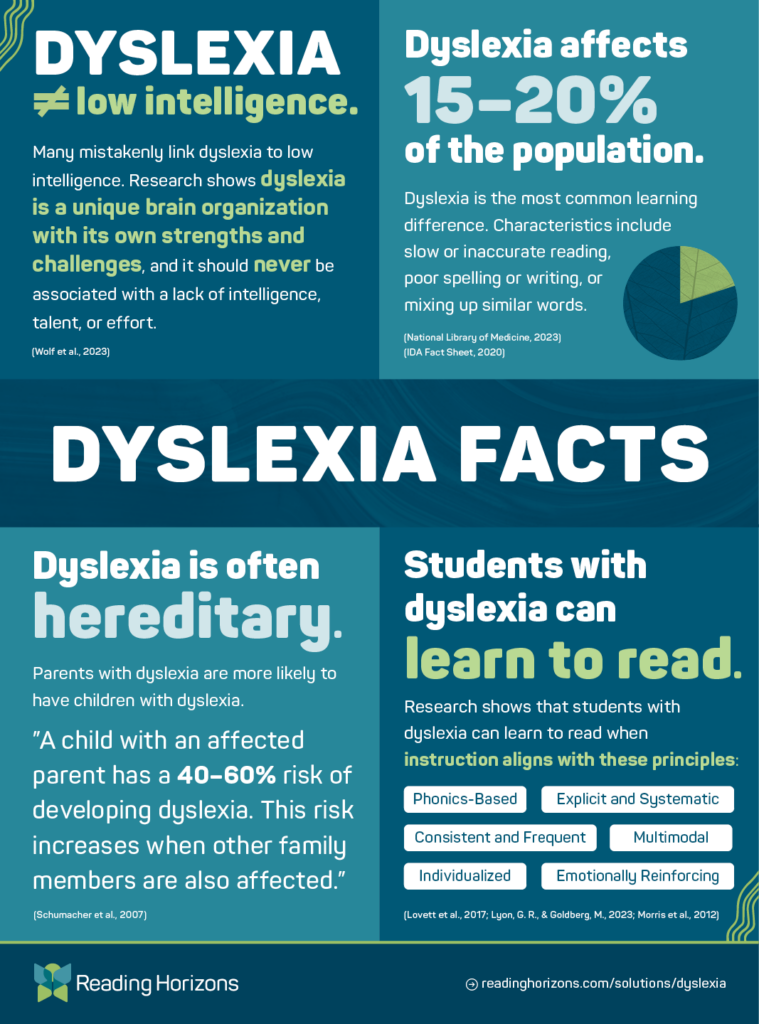
What is Dyslexia?
The word dyslexia is derived from the Greek words “dys” (meaning poor or inadequate) and “lexis” (meaning words or language). This implies an inadequacy only in language tasks.
The first description of dyslexia appeared in 1896 in a piece by Dr. W. Pringle Morgan in Sussex, England: “Percy F., … aged 14, … has always been a bright and intelligent boy, quick at games, and in no way inferior to others of his age. His great difficulty has been—and is now—his inability to learn to read.”
Dyslexia is a specific learning disability that is neurological in origin. It is characterized by difficulties in the use and processing of linguistic and symbolic codes, alphabetic representations of speech sounds, word recognition, and spelling and decoding. These difficulties typically result from a specific weakness in the module of the brain where the sounds of language are put together to form words and where words are broken down into sounds.
Those with dyslexia use only the right side of the brain to process language, while those without dyslexia use three areas on the left side of the brain to process language. Yale researchers have shown that when people with dyslexia try to read, the front part of the brain is overstimulated while crucial portions in the center and back are under-stimulated.
Dr. Glenda Thorne stated, “Dyslexia is not a deficit in the visual processing system; however, it is a language processing problem.”
Dyslexia can affect spoken language, written language, and language comprehension.
Dyslexia often results in a gifted and productive mind that simply learns and functions differently than those without dyslexia.
Misperceptions about Dyslexia
Dyslexia is related to low intelligence
Around 80% of the population believes that dyslexia is associated with low intelligence. This is not true. Dyslexia occurs in people of all intellectual levels.
Here are a few simple tweaks that teachers can apply in the classroom to help students with dyslexia show their true intelligence:
- Provide additional time on tests
- Administer assessments orally
- Give directions one step at a time (not in long lists)
Children outgrow dyslexia
There is no cure for dyslexia; it doesn’t go away with age or treatment. However, there are instructional techniques and compensation strategies that those with dyslexia can use to improve their reading and processing skills.
Research has proven that students with dyslexia can learn to read when taught with a reading curriculum that is:
- Explicit and systematic
- Phonics based
- Multisensory
- Individualized
- Consistent and frequent
- Emotionally reinforcing
Dyslexia makes you see letters backward
Despite popular belief, dyslexia does not make you see letters backward.
- Many kids without dyslexia write letters backward when first learning to write.
- The “b-d” letter reversal is mainly caused by deficits in interpreting left and right.
- Many people with dyslexia pronounce words in reverse order because of the “recency effect,” in which the most recent sound is vocalized first; for instance, saying “tap” for “pat.”
- Many individuals with dyslexia see things in three dimensions, which can affect how they look at words.
Prevalence
“Given the high prevalence of reading difficulties, it is more likely for your child to have a reading problem than almost any other physical problem for which he is being checked.” – Overcoming Dyslexia by Sally Shaywitz, M.D.

- Dyslexia is the most common learning disability.
- 15-20% of the entire U.S. population has some form of dyslexia.
- Only about 5% of the millions of American adults with dyslexia know they have dyslexia.
- If one of your parents has dyslexia, there is a high chance of you having it too. Your chances of getting it are even higher if more of your relatives have dyslexia.
- Around 80% of children placed in special education for a learning disability have dyslexia.
- The numbers of girls and boys who have dyslexia are about the same.
Common Symptoms
The following is a list of common symptoms of dyslexia:
- Poor letter and word recognition
- Difficulty rhyming
- Difficulty listing words that begin with the same sound
- Difficulty connecting letters and letter combinations with the corresponding sounds
- Difficulty decoding unknown words into letter-sound segments
- Poor reading fluency
- Slow, belabored reading
- Reluctance to read and write
- Poor spelling
- Difficulty organizing, planning, prioritizing, keeping time, and concentrating with background noise
- Difficulty remembering dates, names, telephone numbers, and random lists
- Difficulty reading words linearly, left-to-right
- Reading errors that show no connection to spelling
- Difficulty reading small “sight” words such as “that,” “an,” and “in”
- Substituting words with the same meaning for words in the text that the student can’t pronounce, such as “car” for “automobile”
- Omitting parts of words when reading
- Difficulty learning a foreign language
- Beginning to talk late and having trouble with word retrieval
- Having ADHD (for around 40% of people with dyslexia)
Strengths
Because of the strong right brain associated with dyslexia, individuals with dyslexia often excel and show aptitude in areas not associated with reading, such as:
- Art
- Computer science
- Design
- Drama
- Electronics
- Math
- Mechanics
- Music
- Physics
- Sales
- Athletics
Attributes that are often prevalent in individuals with dyslexia:
- Creativity
- Above-average intelligence
- Big picture thinking
- Problem-solving
- Curiosity
- Intuitive nature
- High comprehension of stories read or told to them
- Large spoken vocabulary
- Strong sense of spatial relationships
Sources
http://childmind.org/article/quick-facts-on-dyslexia/
http://www.austinlearningsolutions.com/blog/38-dyslexia-facts-and-statistics.html
